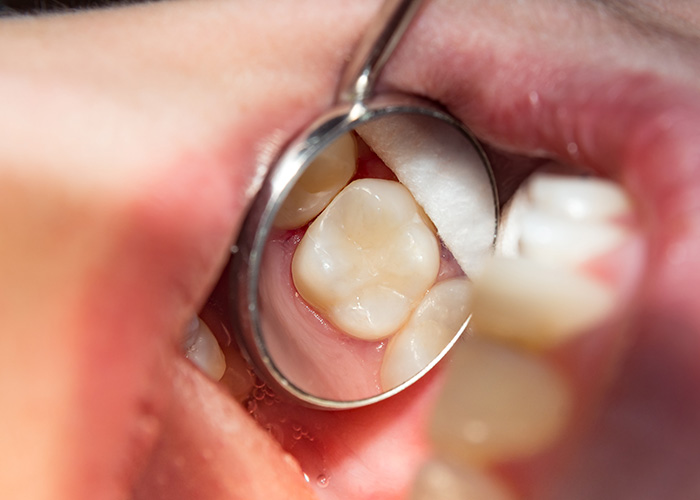
Our Office
2615 West 24th St.
Plainview, TX 79072
Existing Patients: (806) 296-6057
New Patients: (806) 217-7472
Visit Us Online

Tooth-coloured fillings, often called composite or white fillings, are modern restorations made from a resin-based material designed to match the shade of natural teeth. Unlike traditional metal (amalgam) fillings, these restorations are bonded directly to the tooth structure, which helps preserve more of the healthy enamel during preparation. The bonding process creates a tight seal that protects the tooth from further decay while restoring both appearance and function in a subtle, natural way.
Composites are manufactured in a range of shades so that your child’s filling blends seamlessly with the surrounding teeth. The material is layered into the prepared cavity and cured with a special light to harden it quickly. Because the filling is placed in increments, the dentist can sculpt the resin to restore the tooth’s original contours and chewing surfaces, producing a result that looks and feels like a natural tooth.
Beyond aesthetics, contemporary composite materials offer strength and durability suitable for many restorative needs in pediatric dentistry. They perform particularly well in small to medium-sized cavities and are often the preferred choice for front and visible teeth because they maintain the smile’s appearance without drawing attention to the repair.
A white filling becomes an appropriate treatment when a cavity has removed part of a tooth’s structure but there is still enough healthy enamel and dentin to support a restoration. Our pediatric team evaluates the extent of decay, the tooth’s position in the mouth, and the child’s age and oral habits before recommending a filling. For many primary (baby) teeth and permanent teeth with localized decay, a composite filling is an excellent conservative option.
Other factors that influence the recommendation include the child’s risk of future decay, the size and depth of the cavity, and whether the area of the tooth is subject to heavy biting forces. In situations where decay is extensive or a cusp is involved, alternative restorations such as onlays or crowns may be considered, but for routine cavities, white fillings provide a reliable, minimally invasive repair.
One advantage for parents is that placing a white filling does not always require advanced sedation. Many children tolerate the procedure well with local anesthesia and gentle behavior guidance, allowing the dentist to complete treatment efficiently while keeping the experience calm and positive.
The process of placing a tooth-coloured filling starts with a careful assessment and diagnosis, often complemented by X-rays to determine the depth of decay. At the appointment, the tooth is cleaned and isolated to keep the area dry, which is essential for the bonding process. Local anesthesia is used as needed to ensure your child feels no pain during the procedure; our team takes time to make injections comfortable and reassuring.
Once the tooth is numb, the dentist gently removes the decayed tissue and shapes the cavity to create a stable base for the composite. The tooth is then treated with a bonding agent that helps the resin adhere securely. Composite material is applied in thin layers and each layer is cured with a dental light to harden it rapidly. This incremental approach improves strength and reduces shrinkage.
After the final layer is placed and cured, the dentist sculpts and polishes the restoration to match the tooth’s natural shape and smoothness. Your child will be guided through a gentle bite check to make sure the filling sits comfortably with the opposing teeth. The entire visit typically proceeds with calm pacing and clear communication so children and parents know what to expect at each step.
We also provide home care instructions and tips for making the first 24–48 hours after a filling more comfortable, such as avoiding very hard or sticky foods until the bite feels normal. Regular follow-up exams let us monitor the filling’s performance and make adjustments if necessary as your child grows.
White fillings offer several important advantages for children. Because they bond to the tooth, composites can reinforce weakened tooth structure, reducing the need for extensive removal of healthy enamel. This conservative approach helps maintain the integrity of the tooth over time, which is particularly valuable in developing mouths where keeping as much natural tooth as possible supports proper growth.
Aesthetics matter for many families, and white fillings restore a tooth without altering its appearance. This is especially helpful when treating front teeth or areas visible when your child smiles. The natural look also helps avoid the self-consciousness some children feel when a restoration is noticeable, which can make dental visits and ongoing care less stressful for both kids and parents.
Additionally, composites are metal-free and biocompatible, which addresses concerns some families have about traditional materials. Modern composites are engineered to resist wear and perform well under everyday chewing forces, offering a durable solution that balances appearance with function in pediatric dental care.
Maintaining a filling’s longevity starts with good daily oral hygiene. Brushing twice a day with fluoride toothpaste and flossing once daily helps protect the margins where the filling meets natural tooth structure. For younger children who need supervision, parents can assist with brushing to ensure technique and thoroughness. Regular dental checkups allow the dentist to catch early signs of wear or new decay before a small problem becomes larger.
Dietary habits play a significant role in preventing recurrent cavities. Limiting sugary snacks and drinks, encouraging water between meals, and promoting a balanced diet can reduce the frequency of acid attacks on tooth enamel. Your child’s dental team can offer practical, age-appropriate advice about snacks and routines that fit your family’s lifestyle while supporting stronger teeth.
For some patients, preventive measures such as dental sealants or targeted fluoride treatments may be recommended to augment protection in vulnerable areas. These measures complement fillings by lowering the overall risk of future decay, helping to preserve restorations and keep your child comfortable and cavity-free as their permanent teeth erupt.
Routine monitoring is also important: as children grow, bite patterns and tooth positions can change, and fillings may require attention or repair over time. Regular visits help ensure restorations remain functional, comfortable, and cosmetically intact throughout the stages of dental development.
At the office of Texas Super Smiles for Kids, our approach to white fillings combines conservative technique, child-focused care, and clear communication so families feel confident about treatment choices. If you have questions about whether a tooth-coloured filling is the best option for your child or want to learn more about how we place and protect these restorations, please contact us for more information.
Tooth-coloured fillings, also called composite or white fillings, are resin-based restorations that match the shade of natural teeth. They bond directly to the tooth structure, restoring both appearance and function while protecting against further decay.
White fillings are aesthetically pleasing, preserve more healthy tooth structure, and bond directly to the enamel, reinforcing the tooth. They are ideal for visible areas and many pediatric restorations.
White fillings are recommended for small to medium cavities where sufficient healthy tooth structure remains. Factors include the cavity’s size, location, biting forces, and the child’s risk of future decay.
The dentist cleans the cavity, applies a bonding agent, layers the composite resin, and cures each layer with a special light. The filling is then sculpted and polished to restore the tooth’s natural shape and function.
Local anesthesia is used to ensure the procedure is comfortable. Gentle behavior guidance helps children feel calm, making the process painless and stress-free for most patients.
With proper oral hygiene, diet, and regular dental visits, tooth-coloured fillings can last many years. Durability depends on the size of the filling, bite forces, and the child’s habits.
Encourage brushing twice daily with fluoride toothpaste, daily flossing, limiting sugary snacks and drinks, and attending regular dental checkups to monitor the filling’s condition.
Yes. Modern composite materials are biocompatible, metal-free, and designed for durability, making them a safe and effective option for pediatric dental restorations.
Yes. White fillings are ideal for front teeth due to their natural appearance, and they can also be used on small to medium cavities in back teeth where biting forces are moderate.
After placement, children should avoid very hard or sticky foods for the first 24–48 hours. Routine brushing, flossing, and regular dental exams help maintain the filling and prevent future decay.
